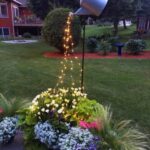Designing a perennial garden layout is a creative and rewarding endeavor that allows you to create a beautiful and sustainable outdoor space. The layout of your garden can greatly impact its overall aesthetic appeal as well as its functionality. By carefully planning the design of your perennial garden, you can create a visually stunning and low-maintenance landscape that offers interest throughout the seasons.
A thoughtfully designed perennial garden layout not only adds beauty to your outdoor space but also provides environmental benefits, attracts beneficial insects, and reduces the need for frequent replanting. The process of designing a perennial garden layout involves careful consideration of various factors such as the selection of the right perennials, evaluating the site, incorporating hardscape features, and maintaining the garden throughout the year.
In this article, we will explore the crucial elements involved in designing an effective perennial garden layout. We will discuss how to select the right perennials for your climate and soil conditions, assess your site for optimum growing conditions, create an appealing garden design, incorporate hardscape features, and provide care tips. Join us on this journey to transform your outdoor space into a stunning perennial oasis that will captivate all who visit.
Selecting the Right Perennials
Designing a perennial garden layout begins with selecting the right perennials to ensure a vibrant and long-lasting display of colors and textures. When choosing perennials, it is important to consider the specific climate and soil conditions of the garden area. Some perennials thrive in sunny, well-drained locations, while others prefer shaded or moist areas. By selecting the right perennials for the site, you can create a low-maintenance garden that will flourish for years to come.
Different Types of Perennials
There is a wide variety of perennials to choose from, including flowers, grasses, and shrubs. Each type offers unique characteristics that can contribute to the overall aesthetic of the garden. For example, ornamental grasses add movement and texture, while flowering perennials provide bursts of color throughout the season.
Considerations for Choosing Perennials
When selecting perennials for your garden layout, it’s important to consider factors such as height, color, and bloom time. Mixing different heights of plants creates visual interest and depth in the garden. Additionally, choosing a variety of bloom times ensures that there are always flowers in bloom throughout the growing season.
Tips for Selecting Perennials
To ensure success with your perennial garden layout, it’s essential to choose plants that are well-suited to your specific growing conditions. This may involve researching which perennials are native to your region or consulting with local gardening experts for recommendations. Paying attention to the plant’s needs regarding sunlight and soil type will also contribute to a successful selection process for creating a beautiful perennial garden layout.
Assessing the Site
When designing a perennial garden layout, one of the most crucial steps is assessing the site where the garden will be located. This step is essential for creating a successful and thriving garden that will bring joy for years to come.
Evaluating Sunlight, Soil, and Drainage
Before planting any perennials, it’s important to assess the sunlight exposure in the area where the garden will be located. Different plants have varying sunlight requirements, so it’s important to understand how much sunlight the site receives throughout the day. Additionally, evaluating the soil type and drainage is vital for ensuring that the perennials will thrive.
Some plants prefer well-drained soil, while others can tolerate more moisture. Understanding these factors will help determine which plants will flourish in the chosen location.
Making the Most of Available Space
Assessing the site also involves making the most of the available space. Consider how much room there is for planting, as well as any potential obstacles or challenges that may need to be addressed. Take note of existing features such as trees or shrubs that could either provide shade or compete with perennials for resources. By carefully evaluating and planning for these existing elements in your garden space, you can avoid future issues and make better use of your space.
Tips for Site Assessment
To make sure you’re fully prepared to design your perennial garden layout, take advantage of various tools available to aid in site assessment. There are apps and websites that can help analyze sunlight exposure based on your location and provide insight into soil types found in your area.
Additionally, consulting with local gardening experts or visiting nearby botanical gardens can provide valuable information specific to your region. Taking these steps during this crucial stage of planning will set you up for success during each subsequent phase of designing and creating your perennial garden layout.
Designing the Layout
When it comes to designing a perennial garden layout, there are several key principles and considerations to keep in mind. Whether you are a seasoned gardener or just starting out, the layout of your perennial garden sets the stage for its overall appearance and functionality. Here are some essential tips for creating a visually appealing and functional perennial garden layout:
1. Consider balance and proportion: Creating a sense of balance is crucial in any garden design. Whether you prefer a formal or informal layout, strive for visual equilibrium by arranging plants and hardscape features in a way that feels harmonious. Pay attention to the size, shape, and color of the elements within the garden to achieve a balanced composition.
2. Explore different layout options: There are various approaches to designing the layout of your perennial garden, from curved borders to straight lines. Consider experimenting with different shapes and patterns to create visual interest. Additionally, think about how you want to move through the space and how different areas will be used when deciding on a layout.
3. Establish focal points: Focal points draw the eye and create an anchor for your garden design. This can be achieved through features such as an ornamental tree, sculpture, or striking plant arrangement. By creating focal points within your perennial garden layout, you can add depth and personality to the space.
By carefully considering these aspects when designing your perennial garden layout, you can create an inviting and visually captivating outdoor space that will flourish for years to come. Remember that good design is not only about aesthetics but also about practicality – aim for a layout that is not only beautiful but also suits your maintenance needs and complements the surrounding landscape seamlessly.
Incorporating Hardscape Features
When designing a perennial garden layout, it’s essential to consider the role of hardscape features in enhancing the overall design and functionality of the space. Hardscape elements, such as paths, borders, and structures, contribute to the aesthetic appeal of the garden while providing practical benefits. Paths create flow and access within the garden, while borders delineate different areas and provide structure. Structures like pergolas or trellises offer vertical interest and can support climbing plants.
Integrating hardscape features with perennial plants requires careful planning to ensure a harmonious and cohesive design. When incorporating paths, consider their width and material to ensure they are functional and visually pleasing. Borders can be used to separate different plantings or define specific areas within the garden layout. When adding structures, such as arbors or benches, consider their placement in relation to the surrounding plants for optimal visual impact.
One of the benefits of adding hardscape features to a perennial garden layout is the opportunity they provide for year-round interest. Unlike many perennials that have specific blooming seasons, well-designed paths, borders, and structures offer visual appeal throughout the year. In winter months when many perennial plants are dormant, hardscape features continue to add structure and beauty to the garden space.
| Key Points | Data |
|---|---|
| Hardscaping Elements | Paths, borders, structures |
| Integration Tips | Consider width/material of path; Placement of structures in relation to plants |
| Year-Round Interest | Hardscape features provide visual appeal during dormant plant seasons |
Caring for Perennial Gardens
Once you have designed and planted your perennial garden, it is essential to understand the maintenance requirements to ensure its long-term health and beauty. Proper care of your perennial garden will help your plants thrive and continue to provide a stunning display year after year.
Watering is a crucial aspect of caring for perennial gardens, especially during the hot summer months. It is important to water deeply and less frequently to encourage deep root growth. Additionally, applying mulch around the plants can help retain soil moisture and suppress weeds, contributing to the overall health of the garden.
Fertilizing your perennial garden is another important task in maintaining its vitality. Choosing a slow-release or organic fertilizer will provide essential nutrients to the plants without risk of overfeeding or burning them. Lastly, staying vigilant against pests and diseases by regularly inspecting your plants will help address any issues before they become a significant problem.
| Topic | Details |
|---|---|
| Watering | Deep watering less frequently; apply mulch |
| Fertilizing | Use slow-release or organic fertilizer |
| Pest Control | Regular inspections to manage pests and diseases |
Seasonal Considerations
When designing a perennial garden layout, it is crucial to consider the seasonal aspects of the plants. By carefully selecting and arranging perennials that bloom at different times of the year, you can ensure that your garden remains vibrant and appealing throughout the seasons. Here are some important considerations for incorporating seasonal variety into your perennial garden layout:
- Selecting a diverse range of perennials: When choosing plants for your garden, consider varieties that bloom in different seasons. This will ensure that there is always something in bloom, providing visual interest and attracting beneficial pollinators throughout the year.
- Planning for continuous color: Aim to have blooms from early spring to late fall by strategically selecting perennials with overlapping bloom times. This will create a dynamic display of colors and textures that evolve as the seasons change.
- Creating focal points for each season: Designate specific areas within your garden to showcase the beauty of different seasonal blooms. For example, plant early spring bulbs near pathways or seating areas where they can be easily enjoyed, and reserve high-impact spots for summer and fall blooming perennials.
By considering seasonal variations and carefully planning the placement of perennials with different bloom times, you can create a stunning and ever-changing display in your perennial garden. Not only will this approach enhance the visual appeal of your garden, but it will also provide essential resources for wildlife throughout the year. With thoughtful consideration given to seasonal dynamics, your perennial garden can become a vibrant and dynamic landscape that evolves beautifully with each passing season.
Keep in mind that while flowers are often considered when adding seasonal variety to a perennial garden layout, foliage color, texture, and structure are also important factors to consider. Incorporating an array of foliage types that change with each season can add depth and interest to your garden design while ensuring its appeal even when flowers may not be in bloom. With careful planning and selection, you can create an ever-evolving masterpiece in your own backyard.
Final Thoughts
In conclusion, designing a perennial garden layout is a rewarding and fulfilling endeavor for any gardening enthusiast. By carefully selecting the right perennials, assessing the site, and incorporating hardscape features, one can create a visually appealing and functional garden space that offers interest throughout the seasons. The principles of good garden design, such as balance, proportion, and focal points, play a crucial role in creating an aesthetically pleasing layout that is also easy to maintain.
As we wrap up our discussion on designing a perennial garden layout, it’s essential to remember that caring for perennial gardens requires ongoing maintenance, including watering, fertilizing, mulching, and pest management. However, the beauty of a well-planned perennial garden in every season makes the effort worthwhile. With thoughtful planning and careful consideration of seasonal factors, it is possible to create a stunning and sustainable garden space that brings joy year after year.
In closing, I encourage all readers to start planning their own perennial garden layout. Whether you have a small space or expansive yard, there are endless possibilities for creating a beautiful and thriving garden with perennials. Embrace the opportunity to unleash your creativity and transform your outdoor space into an oasis of natural beauty. Remember that with dedication and passion for gardening, anyone can create a breathtaking perennial garden that will be enjoyed for years to come.
Frequently Asked Questions
How Do You Layout a Perennial Garden?
When laying out a perennial garden, it’s important to consider the height, bloom time, and color of the plants. Taller plants should be placed towards the back of the garden, while shorter ones can go towards the front.
Grouping plants with similar bloom times or complementary colors together can create an aesthetically pleasing design. It’s also important to consider the sunlight and water needs of each plant when deciding where to place them in the garden.
How Do You Layer Perennials?
Layering perennials involves planting them at different heights within the garden bed. This creates visual interest and allows each plant to have its own space without overshadowing others. Taller perennials can be placed towards the back, medium-height ones in the middle, and shorter ones towards the front. This layering technique adds depth and dimension to the garden design.
How Do You Space Perennials?
Properly spacing perennials is crucial for their growth and overall health. Each plant should have enough room to spread out as they mature, so it’s important not to overcrowd them.
The specific spacing requirements will depend on the type of perennial being planted, so it’s important to research each plant before determining how far apart they should be placed. Additionally, considering their mature size and growth habits will help ensure that they have enough space to thrive in the garden.

Welcome to my gardening blog! I am passionate about plants and enjoy sharing my knowledge and experiences with others. In this blog, I will write about everything related to gardening, from tips on how to get started to updates on my own garden projects.





